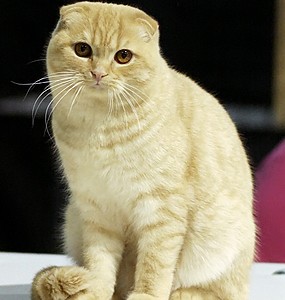History
The story of the Scottish Fold begins in a barn.
In 1961, on a farm in Perthshire, Scotland, a small white cat was found in a barn. Her name was
Susie, and her ears were strange: they were folded down the middle and close to her head, making her look like an owl. When Susie had kittens, two of them were born with folded ears, one of which was taken in by cat fancier William Ross, who registered the cat in Great Britain and began to breed the kittens with the help of a geneticist. It was later discovered that the folded ears were simply the result of a dominant gene expressing itself.
Due to his extreme cuteness, the Scottish Fold is highly sought after and extremely popular.
Cat Facts
Here’s some more information on the Scottish Fold:
- Scottish Fold kittens are born with straight ears that don’t start to fold until about 3-4 weeks of age. Sometimes, the ears don’t fold at all – in fact, only about 40% of kittens develop folded ears. Straight-ear cats are still valuable to the breeding program, however.
- The Scottish Fold’s ears can fold three ways: a single fold, a double fold, or a triple fold.
- Weight: 6-13 pounds
- Lifespan: 12-14 years
 What are they like?
What are they like?
A cat as cute as the Scottish Fold could get away with anything, right?
Actually, the Scottish Fold is one of the sweetest, calmest cat breeds. He loves to be around people big and small, old and young, and also gets along great with other cats and cat-friendly dogs. The Scottish Fold, we have to admit, is kind of a perfect little cat. He’s energetic but not crazy, loves attention but not demanding, and will follow you around the house talking with you in a quiet, soft little voice.
Besides their cute ears, the Scottish Fold will charm you by sitting on his hind legs like a little furry Buddha! The Scottish fold also prefers to sleep on his back.
The Scottish Fold is a pretty healthy breed, but there are some hereditary health problems in the breed:
- Osteochondrodysplasia, a developmental abnormality that affects cartilage and bone development
- Polycystic kidney disease (PKD)
- Cardiomyopathy, a form of heart disease
Right for you?
The Scottish Fold is a pretty neat cat, but there are always a few things to consider when welcoming a new pet into your home:
- Grooming! The Scottish Fold should be combed a couple times a week to keep his fur free of mats and tangles.
- While the Scottish Fold loves to be around people, he tends to bond with a single person in the household.
- The Scottish Fold is not as active as some breeds, but he’s still playful. He’s a great mix of energy and cuddliness!
If you have any questions or concerns, you should always visit or call your veterinarian – they are your best resource to ensure the health and well-being of your pets.
